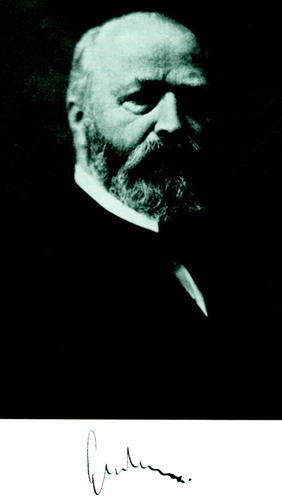Johann Bernhard Aloys von Gudden, 1824–1886
Bernhard von Gudden achieved great accomplishments in the field of biological psychiatry. However, the quality of his work is often overlooked because of the 2 days he spent treating the “Fairy-Tale” King Ludwig II of Bavaria, with whom he later drowned in Starnberg Lake in 1886. Von Gudden was, in fact, a visionary psychiatrist who blended strong interest in neurobiology with humanitarian principles. He was far more than a consulting psychiatrist to the Bavarian royal family.
Von Gudden received his medical degree in 1848 for the study of eye movement. He then worked in the two major German psychiatric hospitals of the time, under the supervision of Karl Wiegand Maximilian Jacobi in the Siegburg asylum and later under Christian Friedrich Wilhelm Roller in the Illenau asylum near Achern, the first model psychiatric hospital in Germany.
At age 31, von Gudden became the director of the Werneck psychiatric hospital, constructed according to the prototype of Illenau. At Werneck, he became the German pioneer of John Conolly’s ideas, translating the principle of nonrestraint into action. In those days, the hematoma of the outer ear—the so-called “otohematoma”—as well as the multiple rib fractures and the trophic neurosis often found in psychiatric patients were unexplainable. Von Gudden linked these afflictions to insufficient care and supervision or even to violence committed by nursing staff in hospitals.
In 1869 von Gudden succeeded Wilhelm Griesinger in Zurich and became director of the newly founded Burghölzi psychiatric hospital. In 1872, he took over the direction of the Oberbayerische Kreis-Irrenanstalt in Munich and became professor of psychiatry at the University of Munich. In Munich, he continued the neuroanatomical studies of the brain he had begun in Werneck and Zurich. Franz Nissl, Emil Kraepelin, Auguste-Henri Forel, and Oskar Panizza worked in von Gudden’s laboratory. Von Gudden applied the technique of secondary degeneration (“Gudden’s method”) to study important interrelations between the cortex and structures of the subcortex. He developed a microtome for sectioning the human brain and described important neuroanatomical centers. The accomplishments of von Gudden’s pupils paved the way for contemporary psychiatry, and his laboratory of neuroanatomy and brain physiology became the germ-cell of the Research Institute for Psychiatry in Munich, which was founded by his master pupil Kraepelin.
At the height of his career, von Gudden was commissioned to provide psychiatric care for the Bavarian royal family. He was the personal doctor of the mentally diseased Prince Rudolf for many years, and in 1886 he was assigned to examine and treat King Ludwig II of Bavaria. On July 13th, 2 days after King Ludwig II was arrested at Castle Neuschwanstein, Ludwig II and Bernhard von Gudden drowned in Starnberg Lake, close to the castle of Berg. The details surrounding their deaths remain unclear.
Address reprint requests to Dr. Müller, Department of Psychiatry, University of Regensburg, Universitätsstr. 84, D-93053 Regensburg, Germany. Image reprinted with permission from Grosse Nervenärzte, Band I, 21 Lebensbilder, 2nd. Ed. Edited by Kolle K. Stuttgart, Georg Thieme, 1970.

Bernhard von Gudden



